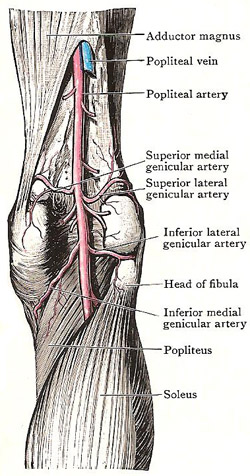popliteal artery

Right popliteal artery and its branches.
The popliteal artery is the continuation of the femoral artery. It begins behind the femur at the opening of the adductor magnus, and it descends to terminate at the distal border of the popliteus muscle by dividing into the anterior and posterior tibial arteries.
Relations of the popliteal artery
The popliteal artery is deeply placed. In the upper part of the fossa, it is under cover of the semimembranosus. Between the condyles, it is covered by fat, and is crossed from lateral to medial side by the popliteal vein and the medial popliteal nerve. In the lower part of the fossa, it is overlapped by the heads of the gastrocnemius, and is crossed by the plantaris and by the nerves to the lateral head of the gastrocnemius, plantaris, soleus, and popliteus. At its termination, it is under cover of the gastrocnemius, and the upper border of the soleus.
Throughout its whole course, the popliteal artery rests against the floor of the popliteal fossa. In its proximal part, it is separated from the femur by some fat; between the condyles of the femur, it crosses the capsule of the knee joint; and, in the distal part of the fossa, it is contact with the fascia of the popliteus muscle.
Branches of the popliteal artery
The branches are muscular, cutaneous, and articular. The muscular branches are distributed to the hamstring muscles and calf muscles of the leg. The cutaneous branches are irregular twigs that arise from the muscular branches; the most constant of them accompanies the upper part of the sural nerve. The articular branches are the five genicular arteries, distinguishable from the muscular branches because they cling to the floor of the fossa and accompany the genicular nerves.


